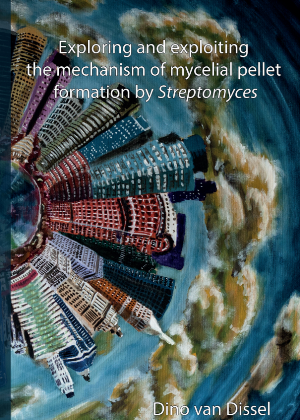Dissertation
Exploring and exploiting the mechanism of mycelial pellet formation by Streptomyces
Promotor: G.P. van Wezel
- Author
- Dino van Dissel
- Date
- 12 December 2016
- Links
- Thesis in Leiden Repository

Streptomyces are multicellular bacteria that grow as branched filaments and are best known for producing the majority of our antibiotics, many immunosuppressant and anticancer compounds. Unfortunately their multicellular life style creates many problems for efficient industrial production. In a bioreactor, depending on the environment and the genetics, it can grow quickly as dispersed mycelia or aggregate in slow growing pellets. Either morphology has advantages and disadvantages, which can be product specific. For my thesis I studied the mechanism by which these filaments can aggregate into dense pellets. I found a small gene cluster that produces poly-1,6-N-acetylglucosamine, a bacterial glue which binds neighboring cells and required for pellet formation in S. coelicolor. Subsequently we can use these genes to control the morphology of streptomycetes in a liquid environment, tailoring it for production. My work has given us new insights in the mechanims through which streptomycetes aggregate, but also has the potential to make streptomycetes a more favorable host for industial production.
